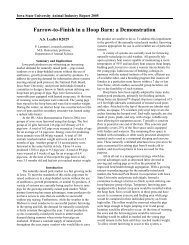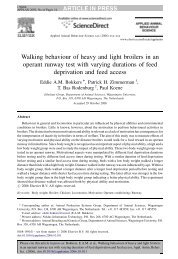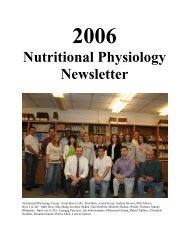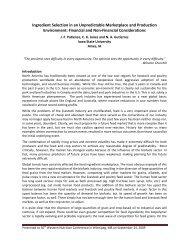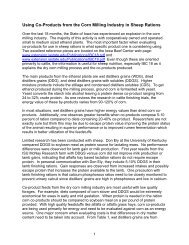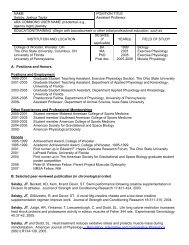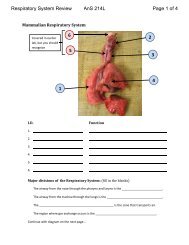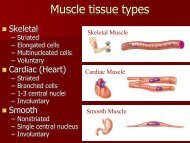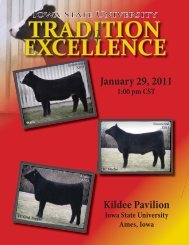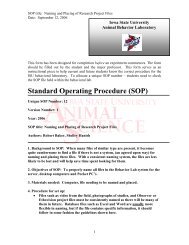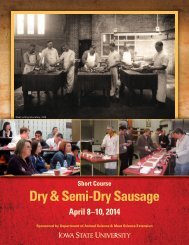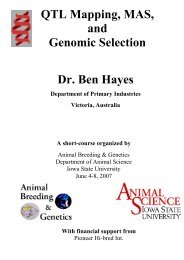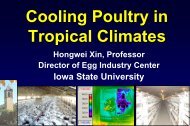Optimum Selection for Identified Major Genes - Department of ...
Optimum Selection for Identified Major Genes - Department of ...
Optimum Selection for Identified Major Genes - Department of ...
You also want an ePaper? Increase the reach of your titles
YUMPU automatically turns print PDFs into web optimized ePapers that Google loves.
Animal Genomics<br />
and<br />
Genomic <strong>Selection</strong><br />
Jack Dekkers<br />
Animal Breeding & Genetics<br />
<strong>Department</strong> <strong>of</strong> Animal Science<br />
Iowa State University
Outline<br />
• Limitations <strong>of</strong> past and current selection strategies<br />
• Including Marker-assisted selection<br />
• A revolution in genomic technology<br />
Genomic or Whole-Genome <strong>Selection</strong><br />
• Opportunities to enhance breeding programs<br />
• Redesign <strong>of</strong> breeding programs<br />
• Dairy cattle example<br />
• Layer chicken example<br />
• <strong>Selection</strong> <strong>for</strong> crossbred per<strong>for</strong>mance in field<br />
• Genetic improvement in developing countries<br />
• Conclusions
Past and Current<br />
<strong>Selection</strong> Strategies<br />
selection<br />
Black box <strong>of</strong><br />
<strong>Genes</strong><br />
Quantitative genetics<br />
h 2<br />
Phenotype<br />
Estimated<br />
Breeding<br />
Value<br />
Environment<br />
Phenotype<br />
<strong>of</strong> relatives
‘70 – ‘00:<br />
= effect <strong>of</strong> # G alleles<br />
Promise <strong>of</strong><br />
Mean<br />
weight (kg)<br />
Effect ‘G’ allele = +5<br />
105<br />
100<br />
Molecular Genetics<br />
95<br />
G<br />
G<br />
G<br />
A<br />
A<br />
A<br />
Q<br />
Q<br />
Q<br />
q<br />
q<br />
q<br />
Find major genes<br />
or<br />
markers linked to QTL<br />
and use these <strong>for</strong><br />
Marker-Assisted <strong>Selection</strong>
Use <strong>of</strong> MAS to enhance <strong>Selection</strong><br />
Molec.<br />
<strong>Genes</strong><br />
genetics<br />
<strong>Major</strong> genes<br />
Markers<br />
QTL<br />
Phenotypic<br />
data<br />
Molecular<br />
data<br />
Marker-Assisted<br />
<strong>Selection</strong><br />
• Expressed in both sexes<br />
• Expressed at early age<br />
• Doesn’t require phenotypes on<br />
animal itself or close relatives
Estrogen Receptor Gene<br />
(Rothschild et al. 1991, Short et al. 1997)<br />
Effect on Number Born Alive<br />
ESR First parity Later parities<br />
genotype n=4,262 n=4,753<br />
AA 9.4 10.0<br />
AB 9.9 10.5<br />
BB 10.2 10.7
a<br />
Allele 1<br />
homozygote<br />
sequence<br />
Allele 2<br />
homozygote<br />
sequence<br />
293 295 297 299 300<br />
C N S I I D P L I Y<br />
C N S I I N P L I Y<br />
MC4R mutation<br />
and Test<br />
(Kim et al., Mam. Gen. 2000)<br />
H 2<br />
Transmembrane<br />
domains<br />
I II III IV V VI VII<br />
1/1 2/2 1/2<br />
COO<br />
H<br />
11 vs 22 genotype<br />
in 2 commercial types<br />
Backfat<br />
(mm)<br />
Loin<br />
depth<br />
(mm)<br />
Daily<br />
Gain<br />
(g/d)<br />
Daily<br />
Feed<br />
Intake<br />
(kg/d)<br />
542<br />
466<br />
-1.3 +1.4 -26.0 -0.15<br />
P
Many markers and<br />
QTL have been<br />
reported but few<br />
have been utilized<br />
Examples <strong>of</strong> gene<br />
tests in<br />
commercial<br />
breeding<br />
D = dairy cattle<br />
B = beef cattle<br />
C = poultry<br />
P = pigs<br />
S = sheep<br />
Dekkers, 2004, J.Anim.Sci<br />
Trait Direct markers LD markers LE LE markers<br />
Congenital BLAD (D)<br />
defects<br />
Citrulinaemia (D,B)<br />
DUMPS (D)<br />
CVM (D)<br />
Maple syrup urine (D,B)<br />
Mannosidosis (D,B)<br />
RYR (P)<br />
RYR (P)<br />
Appearance CKIT (P) Polled (B)<br />
MC1R/MSHR (P,B,D)<br />
MGF (B)<br />
Milk quality<br />
-Casein (D)<br />
-lactoglobulin (D)<br />
FMO3 (D)<br />
Meat quality RYR (P) RYR (P)<br />
RN/PRKAG3 (P)<br />
RN/PRKAG3 (P)<br />
A-FABP/FABP4 (P)<br />
H-FABP/FABP3 (P)<br />
CAST (P, B)<br />
>15 PICmarq TM (P)<br />
THYR (B)<br />
Leptin (B)<br />
Feed intake<br />
MC4R (P)<br />
Disease Prp (S) B blood group (C)<br />
F18 (P)<br />
K88 (P)<br />
Reproduction Booroola (S) Booroola (S)<br />
Inverdale(S)<br />
ESR (P)<br />
Hanna (S)<br />
PRLR (P)<br />
RBP4 (P)<br />
Growth &<br />
composition<br />
Milk yield &<br />
composition<br />
MC4R (P) CAST (P) QTL (P)<br />
IGF-2 (P)<br />
IGF-2 (P)<br />
Myostatin (B)<br />
QTL (B)<br />
Callipyge (S)<br />
Carwell (S)<br />
DGAT (D) PRL (D) QTL (D)<br />
GRH (D)<br />
-Casein (D)
Reasons <strong>for</strong> limited<br />
use <strong>of</strong> Genetic Markers<br />
• Available markers only explain a limited % <strong>of</strong><br />
genetic variance<br />
• High genotyping costs<br />
• Marker effects are not always consistent<br />
across populations
Since 2000: A Revolution in Molecular Technology<br />
2.8 million SNPs<br />
Nature 2004<br />
Single<br />
Nucleotide<br />
Polymorphisms<br />
High-through-put<br />
SNP genotyping<br />
International Swine Genome<br />
Sequencing Consortium<br />
AAGCCTTGATAATT<br />
maternal<br />
paternal<br />
AAGCCTTGCTAATT<br />
NOW AVAILABLE:<br />
Illumina Bovine 50k Beadchip<br />
+ discovery <strong>of</strong> many<br />
Single<br />
Nucleotide<br />
Polymorphisms<br />
SNPs<br />
50,000 DNA tests <strong>for</strong>
How to use these new tools<br />
Genotype large # <strong>of</strong><br />
Individuals<br />
<strong>for</strong> large numbers <strong>of</strong> SNPs<br />
+ collect their phenotypes<br />
Statistical Analysis<br />
to estimate SNP effects
Repeat <strong>for</strong> all 50,000 SNPs<br />
Estimation <strong>of</strong><br />
SNP effects<br />
AAGCCTTGATAATT<br />
Progeny tested bulls grouped by SNP genotype<br />
A<br />
A<br />
A<br />
C<br />
C<br />
C<br />
SNP<br />
Genotype<br />
AAGCCTTGCTAATT<br />
Average EBV<br />
protein yield<br />
AA +20<br />
AC +15<br />
CC +10<br />
SNP effect estimate = +5 <strong>for</strong> A
Use <strong>of</strong> high-density SNPs<br />
Genotype large # <strong>of</strong><br />
Individuals<br />
<strong>for</strong> large numbers <strong>of</strong> SNPs<br />
+ collect their phenotypes<br />
Statistical Analysis<br />
to estimate effect <strong>of</strong> each SNP<br />
Use only<br />
significant SNPs<br />
<strong>for</strong> MAS<br />
Use all<br />
SNPs<br />
<strong>for</strong> MAS<br />
Genomic<br />
selection<br />
(Meuwissen et al. ‘01)
Genomic <strong>Selection</strong><br />
Breeding Value Estimation using<br />
high-density SNPs<br />
Meuwissen et al. 2001 Genetics<br />
• All SNPs are analyzed simultaneously, i.e. 50,000 vs. 1 at a time<br />
y i = m + S k g ik<br />
SNP k<br />
+ e i<br />
Estimates <strong>of</strong> SNP effects k<br />
Implemented using Bayesian methods<br />
Or by using genomic vs. pedigree<br />
relationships in animal model BLUP (GBLUP)<br />
^<br />
Use to estimate<br />
breeding value <strong>of</strong> new<br />
animals based on SNP<br />
genotypes alone<br />
^<br />
Genomic EBV = S k g ik
Animal<br />
Example Genomic EBV<br />
with 3 SNPs<br />
with estimated effects ( <strong>for</strong> # A alleles) <strong>of</strong>:<br />
SNP 1 SNP 2 SNP 3<br />
Genotype Value Genotype Value Genotype Value<br />
GEBV<br />
1 AA +10 AA +5 AA -10 +5<br />
2 AA +10 AA +5 BB +10 +25<br />
3 AB 0 BB -5 AB 0 -5<br />
4 AB 0 BB -5 AA -10 -15<br />
5 BB -10 AA +5 AB 0 -5<br />
^<br />
+10 <strong>for</strong> SNP 1<br />
+ 5 <strong>for</strong> SNP 2<br />
–10 <strong>for</strong> SNP 3<br />
Genomic EBV = S^ k g ik
Genomic <strong>Selection</strong><br />
Meuwissen et al. 2001<br />
<strong>Selection</strong> based on high-density SNP genotyping<br />
Select at young age<br />
Phenotype<br />
Genotype<br />
<strong>for</strong> >30,000<br />
SNPs<br />
Genotype<br />
<strong>for</strong> >30,000<br />
SNPs<br />
Genotype<br />
<strong>for</strong> >30,000<br />
SNPs<br />
Training data<br />
Estimate<br />
effect <strong>of</strong><br />
each SNP<br />
Predict BV<br />
from marker<br />
genotypes at<br />
early age<br />
Predict BV<br />
from marker<br />
genotypes at<br />
early age
Genomic EBV increase accuracy<br />
<strong>for</strong> young animals<br />
E.g. <strong>for</strong> Young Holstein Bulls<br />
(VanRaden and Tooker, 2009 USDA-AIPL)<br />
ftp://aipl.arsusda.gov/pub/outgoing/GenomicReliability0608.doc<br />
Trait<br />
Net merit + 23<br />
Milk yield + 32<br />
Fat yield + 36<br />
Protein yield + 28<br />
Productive life + 33<br />
Dtr. Pregancy rate + 20<br />
Gain over parent average<br />
reliability (~39%)
The Promise <strong>of</strong> Genomic <strong>Selection</strong><br />
(based on simulation)<br />
• Ability to increase accuracy <strong>of</strong> EBV<br />
at a young age<br />
• Reduce generation intervals<br />
• Reduce rates <strong>of</strong> inbreeding<br />
• Reduce requirement to obtain<br />
phenotypes on selection candidates<br />
and / or on close relatives
Outline<br />
• Limitations <strong>of</strong> past and current selection strategies<br />
• Including Marker-assisted selection<br />
• A revolution in genomic technology<br />
Genomic or Whole-Genome <strong>Selection</strong><br />
• Opportunities to enhance breeding programs<br />
• Redesign <strong>of</strong> breeding programs<br />
• Dairy cattle example<br />
• Layer chicken example<br />
• <strong>Selection</strong> <strong>for</strong> crossbred per<strong>for</strong>mance in field<br />
• Genetic improvement in developing countries<br />
• Conclusions
ow could Genomic <strong>Selection</strong> change dairy breeding<br />
Illumina Bovine 50k Beadchip<br />
Superior progenytested<br />
bull<br />
X<br />
Embryo<br />
Transfer<br />
Superior genometested<br />
young bull<br />
5 yrs<br />
&<br />
$$$$$$<br />
later<br />
Semen<br />
samples<br />
Which is best<br />
DNA<br />
samples<br />
< 6 mo<br />
&<br />
$$<br />
later
Implementation <strong>of</strong> Genomic<br />
<strong>Selection</strong> in Layer Chickens<br />
Jack Dekkers 1 , Chris Stricker 2<br />
Rohan Fernando 1 , Dorian Garrick 1 , Susan Lamont 1<br />
Neil O’Sullivan 3 , Janet Fulton 3 , Jesus Arango 3 , Petek Settar 3<br />
Andreas Kranis 4 , Jim McKay 5 , Kellie Watson 4 ,<br />
Alfons Koerhuis 4 , Rudi Preisinger 6<br />
1<br />
Iowa State University<br />
2<br />
applied genetics network,<br />
3<br />
Hy-Line Int<br />
4<br />
Aviagen Ltd.,<br />
5<br />
EW Group<br />
6<br />
Lohmann Tierzucht
Implementation <strong>of</strong> Genomic<br />
<strong>Selection</strong> in Layer Chickens<br />
Research Objective<br />
Evaluate and demonstrate<br />
the advantages and pitfalls <strong>of</strong> Genomic <strong>Selection</strong><br />
in a commercial breeding population<br />
Research Questions / Goals<br />
In layer chickens, Genomic <strong>Selection</strong> can:<br />
• increase response by halving the generation interval<br />
• without increasing the rate <strong>of</strong> inbreeding per year<br />
• in a breeding program comprising fewer individuals
Implementation<br />
A Commercial Breeding Line was split in two<br />
Traditional and Genomic Selectrion compared side-by-side<br />
<strong>Selection</strong> strategy Traditional Genomic<br />
<strong>Selection</strong> parameters ♂♂ ♀♀ ♂♂ ♀♀<br />
# candidates/gener. 1,000 3,000 300 300<br />
# phenotyped a 3,000 300<br />
# selected 60 360 50 b 50 b<br />
Generation interval 12 mo c 12 mo c 6 mo d 6 mo d<br />
a Complete phenotypes available at ~10 months <strong>of</strong> age<br />
b<br />
Equal selection <strong>of</strong> ♂ and ♀ maximizes response <strong>for</strong> given F<br />
c Traditional selection is after ♀♀ are phenotyped 12 mo.<br />
Traditional selection is limited by cost to rear and phenotype<br />
Male traditional selection is on sib data low accuracy high F
Expected Response and Inbreeding<br />
Based on simulation
Outline<br />
• Limitations <strong>of</strong> past and current selection strategies<br />
• Including Marker-assisted selection<br />
• A revolution in genomic technology<br />
Genomic or Whole-Genome <strong>Selection</strong><br />
• Opportunities to enhance breeding programs<br />
• Redesign <strong>of</strong> breeding programs<br />
• dairy cattle example<br />
• Layer chicken example<br />
• <strong>Selection</strong> <strong>for</strong> crossbred per<strong>for</strong>mance in field<br />
• Genetic improvement in developing countries<br />
• Conclusions
Current Pyramid <strong>Selection</strong> Programs<br />
Limitations: - limited selection <strong>for</strong> per<strong>for</strong>mance in the field<br />
- no selection <strong>for</strong> traits not recorded in nucleus<br />
- disease traits<br />
Sire<br />
line<br />
NUCLEUS<br />
herds<br />
Dam<br />
line<br />
High health<br />
environment<br />
Multiplier<br />
Multiplier<br />
r g < 1<br />
Crossbred animals in<br />
Production herds<br />
Field<br />
environment
Field data on relatives<br />
<strong>Selection</strong> <strong>for</strong> Per<strong>for</strong>mance in Field<br />
‘Traditional’ Breeding Solution:<br />
Collect phenotypes on relatives in field<br />
Combined Crossbred-Purebred <strong>Selection</strong><br />
Purebred<br />
data<br />
Sire<br />
line<br />
Multiplier<br />
Crossbred animals in<br />
Production herds<br />
<br />
<br />
G field<br />
F<br />
Bijma & van Arendonk, ‘98<br />
Requirements/limitations:<br />
- Costly logistics - Pedigree-based<br />
phenotyping in field<br />
- Longer generation intervals<br />
- Higher rates <strong>of</strong> inbreeding<br />
- family data vs. own phenotype
<strong>Selection</strong> <strong>for</strong> Per<strong>for</strong>mance in Field<br />
Genomic <strong>Selection</strong> Solution<br />
Genomic<br />
<strong>Selection</strong><br />
(Dekkers 2007 JAS)<br />
Genomic selection using SNP<br />
effects estimated in field data<br />
Genomic<br />
EBV<br />
^<br />
^<br />
S k g ik<br />
g ik<br />
Genotype<br />
Sire<br />
line<br />
Multiplier<br />
Advantages:<br />
- Potential to increase response<br />
and reduce inbreeding<br />
- Removes requirement <strong>for</strong><br />
pedigree-based phenotypes<br />
- Opportunities to select <strong>for</strong><br />
traits not observed in nucleus<br />
SNP effect<br />
estimates<br />
Genotype<br />
Phenotype<br />
Crossbred animals in<br />
Production herds<br />
(Ibanez-Escriche, Fernando, Toosi, Dekkers, GSE, 2009)
Genetic Improvement in Developing Countries<br />
Limitations<br />
• G x E interactions<br />
• Limited acceptance<br />
by local farmers<br />
• Lack <strong>of</strong> pedigree<br />
at field level<br />
Nucleus<br />
Breeding<br />
Program<br />
Bulls<br />
or<br />
Semen<br />
Field<br />
population
Genotype<br />
Phenotype<br />
Genetic Improvement in Developing Countries<br />
Potential Genomic <strong>Selection</strong> Solution<br />
Bulls or<br />
Semen<br />
Identify best<br />
genetics in the<br />
field using<br />
Genomic EBV<br />
S^ k g ik<br />
Genotype<br />
g ik<br />
Field<br />
population<br />
^<br />
SNP effect<br />
estimates
Outline<br />
• Limitations <strong>of</strong> past and current selection strategies<br />
• Including Marker-assisted selection<br />
• A revolution in genomic technology<br />
Genomic or Whole-Genome <strong>Selection</strong><br />
• Opportunities to enhance breeding programs<br />
• Redesign <strong>of</strong> breeding programs<br />
• dairy cattle example<br />
• Layer chicken example<br />
• <strong>Selection</strong> <strong>for</strong> crossbred per<strong>for</strong>mance in field<br />
• Genetic improvement in developing countries<br />
• Conclusion
College <strong>of</strong> Agriculture and Life Sciences<br />
Genomic <strong>Selection</strong> has potential to<br />
revolutionize Animal Breeding<br />
by removing limitations on<br />
• when<br />
• where<br />
• and on which animals<br />
phenotypes are recorded<br />
• With opportunities to<br />
• reduce generation intervals<br />
• reduce inbreeding<br />
• improve field per<strong>for</strong>mance<br />
• reduce phenotyping costs



